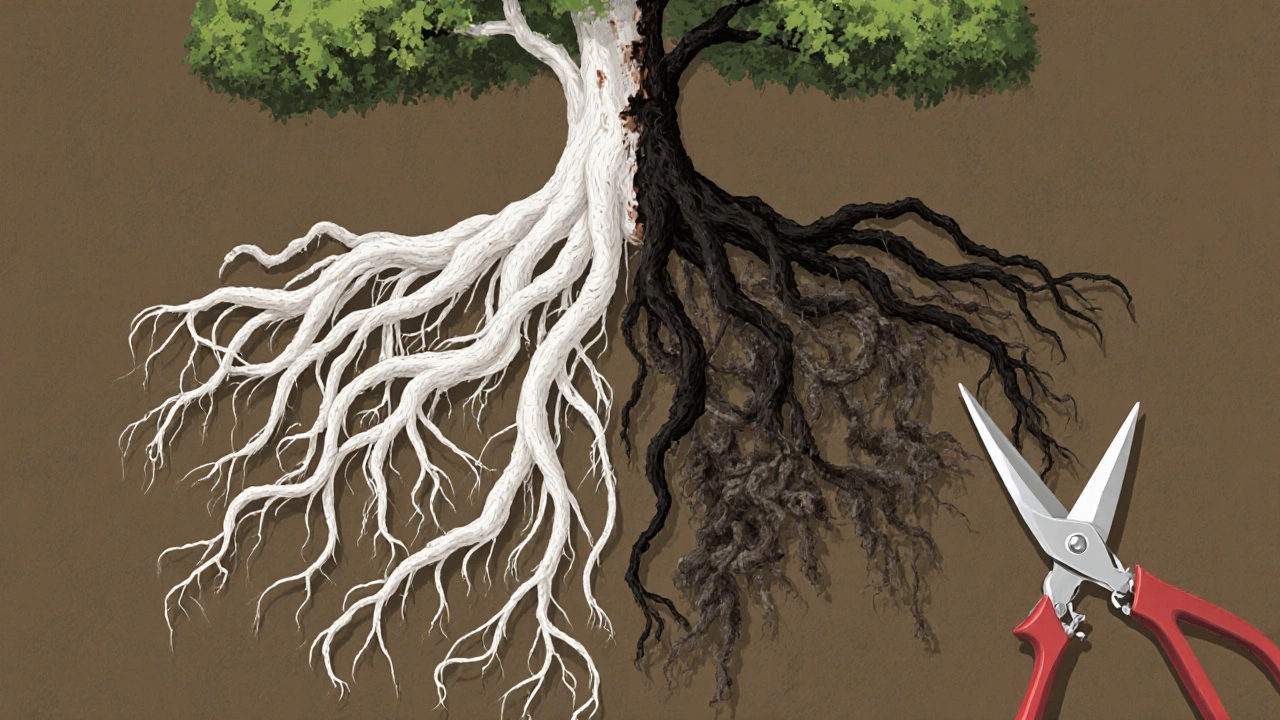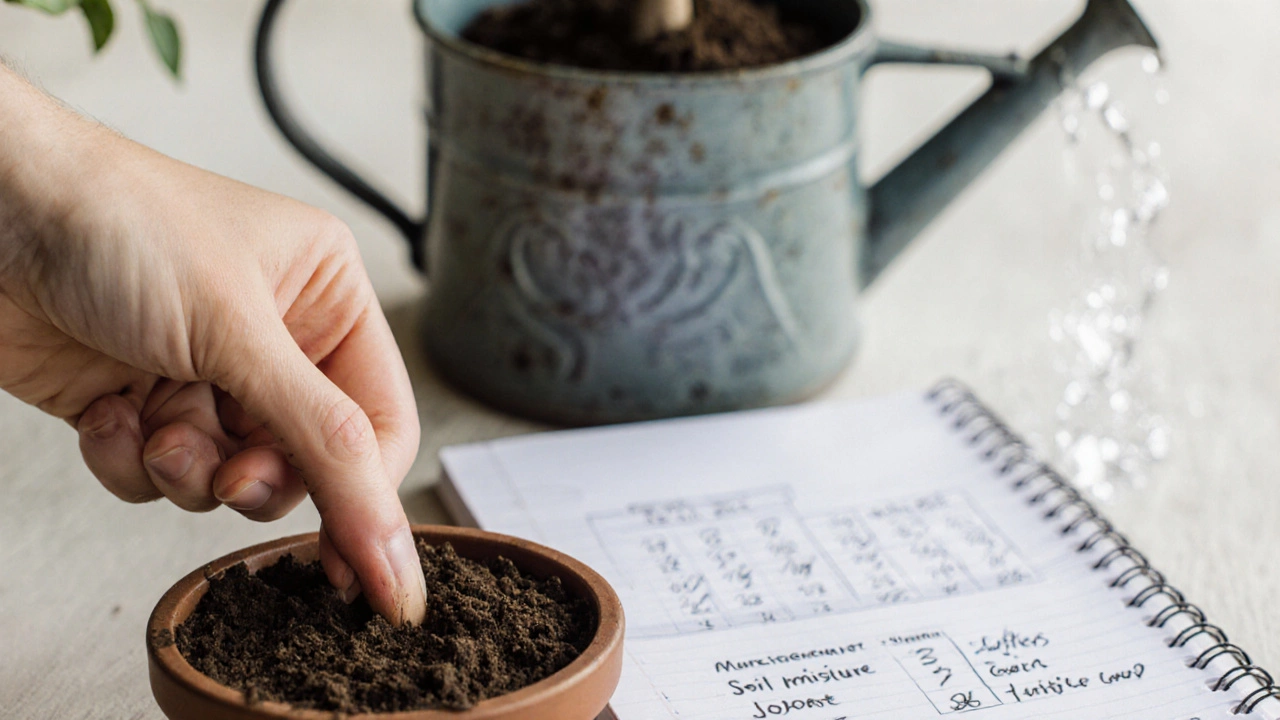Bonsai Water Checker
Check Soil Moisture
How dry is the top inch of soil?
Check Leaf Symptoms
Select symptoms present
Most people kill their bonsai trees not by forgetting to water them, but by watering them too much. It’s the number one mistake beginners make. You love your bonsai. You see it sitting there, quiet and still, and you think, It looks thirsty. So you reach for the watering can again. And again. And again. Before you know it, the roots are drowning, the leaves are turning yellow, and the tree is slipping away. But here’s the truth: overwatered bonsai don’t always look dry. In fact, they often look perfectly normal-until it’s too late.
How to Spot an Overwatered Bonsai Tree
An overwatered bonsai doesn’t scream for help. It whispers. And by the time you hear it, the damage is already done. The first sign isn’t always wilting. It’s subtle. Look at the leaves. If they’re turning yellow and falling off without any obvious reason-no bugs, no sunburn, no sudden temperature drop-you’ve got a problem. Healthy bonsai leaves stay green and firm. When they start softening and losing color, especially on the lower branches, water is likely the culprit.
Check the soil. If it’s still wet two days after watering, you’re overdoing it. Most bonsai soils drain fast-pine bark, akadama, pumice. They’re designed to dry out between waterings. If your soil stays soggy, your roots can’t breathe. Roots need oxygen just like your lungs. Without it, they start to rot. And once root rot sets in, the tree can’t absorb water or nutrients anymore. That’s when the leaves turn brown, curl, and drop in clusters.
Another red flag: mold or algae on the soil surface. A thin green film isn’t dangerous, but thick, fuzzy patches mean the soil is staying damp too long. That’s a breeding ground for fungi that attack roots. If you see it, stop watering immediately. Let the soil dry out completely before you touch the can again.
Why Overwatering Happens
You’re not alone. Most people water bonsai on a schedule: every three days, every Monday and Thursday. That’s the wrong approach. Bonsai don’t care about your calendar. They care about the soil. Watering by the clock ignores humidity, temperature, pot size, and tree species. A juniper bonsai in a small ceramic pot on a sunny balcony needs water every 2-3 days in summer. A ficus in a plastic pot indoors might go a full week without a drop.
Another common mistake: using regular potting soil. It holds water like a sponge. Bonsai need gritty, fast-draining mixes. If you’re using store-bought potting soil, you’re setting your tree up for failure. Even if you water sparingly, the soil stays wet too long. That’s why many bonsai die slowly-drowning in soil that was never meant to hold moisture.
And then there’s the pot. Deep pots, narrow drainage holes, saucers that never empty-these all trap water. A bonsai pot should have at least two large drainage holes. If yours has one small hole or none at all, that’s a problem. Water pools at the bottom. Roots sit in it. Rot begins.
What Overwatering Does to the Roots
Root rot is silent. You won’t see it until the tree starts collapsing. But if you pull your bonsai out of the pot and see black, mushy roots instead of firm, white or tan ones-you’ve got root rot. Healthy roots feel springy, like rubber bands. Dead roots crumble like wet tissue paper. If more than 30% of the root system is damaged, the tree won’t recover without major surgery.
Root rot doesn’t just kill roots. It kills the whole tree. The roots are the tree’s lifeline. They pull water and nutrients from the soil and send them up to the leaves. When they rot, the tree starves. Even if you keep watering, the tree can’t use it. That’s why overwatered bonsai often look like they need more water-they’re actually dying from dehydration caused by dead roots.

How to Save an Overwatered Bonsai
If you catch it early, you can still save your tree. First, stop watering. Let the soil dry out completely. Move the tree to a spot with good airflow and bright, indirect light. Don’t put it in direct sun-it’s already stressed. Next, check the drainage. If the pot has no holes or they’re clogged, repot it. Use a proper bonsai soil mix: 50% akadama, 25% pumice, 25% lava rock. That’s the gold standard for drainage.
When you repot, trim away any black, mushy roots. Use clean, sharp scissors. Cut back until you only see healthy tissue. Then repot in fresh soil. Don’t fertilize. Don’t prune the branches. Just let the tree rest. Water it once, lightly, after repotting. Then wait. Wait another 7-10 days before watering again. Let the soil dry out fully between waterings.
Recovery takes time. Weeks, sometimes months. Don’t expect new growth right away. The tree is healing. It’s not dead. It’s just waiting. If you see one new bud after a month, that’s a win. Two buds? You’ve turned the tide.
How to Water Your Bonsai Right
Forget the schedule. Here’s how to water correctly:
- Stick your finger into the soil up to the first knuckle. If it’s damp, wait.
- If it’s dry, water slowly until water runs out the drainage holes.
- Let the pot sit for 10 minutes, then empty the saucer. Never let the pot sit in water.
- Wait until the top inch of soil is dry before watering again.
Use a watering can with a fine rose nozzle. It mimics light rain and won’t wash away the soil. Water in the morning so excess moisture can evaporate during the day. Avoid evening watering-it traps moisture overnight.
Seasons matter. In winter, many bonsai go dormant. They need water once every 2-3 weeks. In summer, they might need water every 2-3 days. But never guess. Always check the soil.

What Not to Do
Don’t mist your bonsai thinking it’s helping. Misting adds zero moisture to the roots. It just raises humidity, which can encourage mold. Don’t use ice cubes. Don’t pour water from a bottle without checking the soil. Don’t assume your neighbor’s bonsai watering routine works for yours. Every tree is different.
And never, ever use a self-watering pot. They’re designed for houseplants that like constant moisture. Bonsai are not houseplants. They’re miniature trees that evolved to survive in rocky, dry conditions. Constant moisture kills them.
When to Give Up
If the trunk is soft, the branches are brittle, and the bark is peeling off easily, the tree is gone. Root rot has spread too far. No amount of watering or repotting will save it. That’s heartbreaking, but it happens. Don’t blame yourself. Learn from it. Next time, check the soil before you water. Keep a small notebook. Write down the date you watered and how dry the soil felt. After a few months, you’ll start to recognize the patterns. You’ll know exactly when your tree needs water-even before it asks.
Bonsai aren’t hard to care for. They just need patience. And a little humility. You’re not the boss of the tree. You’re the caretaker. And sometimes, the best thing you can do is wait-and stop watering.
Can a bonsai tree recover from overwatering?
Yes, if caught early. Stop watering immediately, let the soil dry out, and repot the tree in fresh, well-draining bonsai soil. Trim away any black or mushy roots. After repotting, wait 7-10 days before watering again. Recovery can take weeks or months, but new buds are a good sign the tree is healing.
How often should I water my bonsai?
There’s no fixed schedule. Water only when the top inch of soil feels dry. This could be every 2-3 days in summer or once every 2-3 weeks in winter. Always check the soil with your finger before watering. Never rely on the calendar.
Why are the leaves on my bonsai turning yellow?
Yellowing leaves are often a sign of overwatering, especially if the soil stays wet and the roots are soft. But it can also be caused by underwatering, poor soil, or lack of light. Check the soil moisture and root health. If roots are black and mushy, overwatering is the likely cause.
What soil is best for bonsai trees?
Use a gritty, fast-draining mix: 50% akadama, 25% pumice, and 25% lava rock. This allows water to drain quickly while holding just enough moisture for the roots. Avoid regular potting soil-it holds too much water and causes root rot.
Should I use a saucer under my bonsai pot?
You can use a saucer to catch runoff, but never let the pot sit in standing water. After watering, wait 10 minutes, then empty the saucer completely. Bonsai roots will rot if they’re constantly sitting in water.

